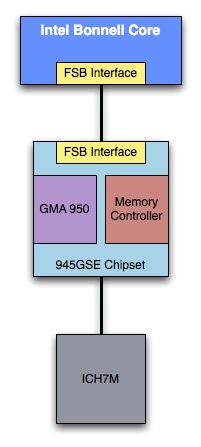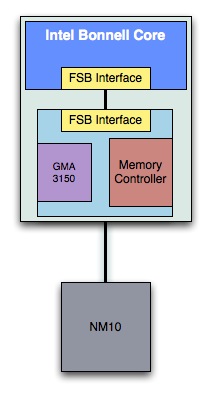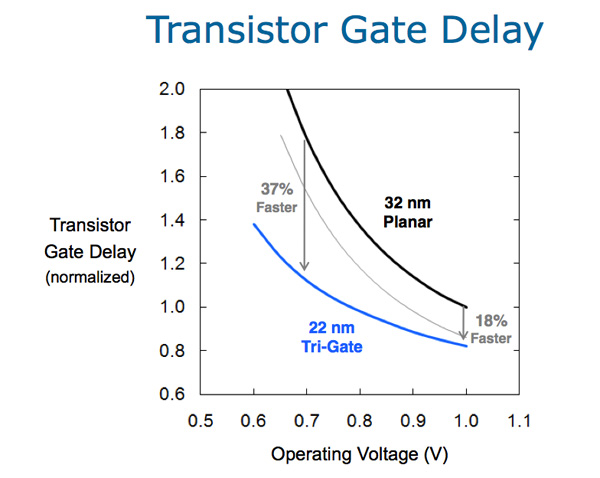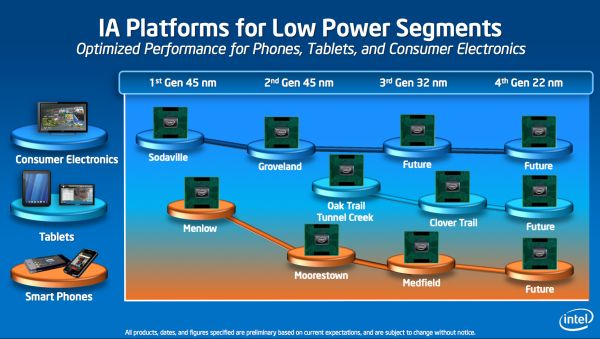Intel's Silvermont: A New Atom Architecture
by Anand Lal Shimpi on May 12, 2011 6:18 PM EST- Posted in
- CPUs
- Intel
- Atom
- Silvermont
- SoCs
Brooke Crothers broke a very important story today - he published the name Silvermont. Atom's first incarnation came to us in 2008 as a Pentium-like dual-issue in-order microprocessor. The CPU core was named Bonnell, after the tallest point in Austin at around 750 feet. Small mountain, small core. Get it?
Bonnell and the original Atom were developed on a 5-year cadence, similar to how Intel ran things prior to the Core 2 revolution (the P6 to Netburst/Pentium 4 move took 5 years). With the original chip out in 2008, five more years would put the next major architecture shift at 2013, which happens to be exactly when the Cnet report mentions Silvermont will be introduced.
When I first met with the Atom design team they mentioned that given the power budget and manufacturing process, the Bonnell design would be in-order. You get a huge performance boost from going to an out-of-order architecture, but with it comes a pretty significant die area and power penalty. I argued that eventually Intel would have to consider taking Atom out of order, but the architects responded that Atom was married to its in-order design for 5 years.
and_PlatformControllerHub_package2_sm.jpg)
Intel's Moorestown - same Atom core, just more integrated
Since 2008, Atom hasn't had any core architecture changes. Sure Intel integrated the GPU and memory controller, however the CPU still communicates with both of them over an aging FSB. The CPU itself remains mostly unchanged from what we first saw in 2008. Even Intel's 32nm Atom due out by the end of this year doesn't change its architecture, this is the same dual-issue in-order core that we've been covering since day 1. The 32nm version just runs a bit quicker and is paired with a beefier GPU.
|
Intel Atom "Diamondville" Platform 2008
|
Intel Atom "Pine Trail" Platform 2009-2010
|
 |
 |
Silvermont however changes everything. It is the first new redesign of the Atom architecture and it marks the beginning of Atom being on a tick-tock cadence. Say goodbye to 5 year updates, say hello to a new architecture every 2 years.
Given what Intel said about Atom being in-order for 5 years, I think it's safe to say that Silvermont is an out-of-order microprocessor architecture. The other big news is that Silvermont will be built using Intel's 22nm transistors. What may not have been possible at 45nm gets a lot easier at 22nm. Assuming perfect scaling, a chip built on Intel's 22nm process would be a quarter the size of the same chip built at 45nm. With Apple paving the way for 120mm2+ SoCs, Silvermont can be much more complex than any Atom we've seen thus far.

Intel's 22nm transistors offer huge gains at low voltages, perfect for Silvermont
By 2013 Intel's 22nm process should be very mature, which maintains Intel's sensible design policy of only moving to a new architecture or a new process, but not both at the same time in order to minimize risk. With 22nm debuting in Ivy Bridge at the end of this year (with availability sometime in 1H 2012), this puts Silvermont at a full year behind
Intel isn't talking core counts at this point, but for 2013 I'd expect both monolithic dual and quad-core variants. If we use history as any indicator, Intel will likely drop the FSB in favor of a point-to-point bus interface between Silvermont and its cohorts.
The big question is about GPU technology. Intel has historically used GPUs licensed from Imagination Technologies in its smartphone/tablet/MID line, while opting for its own in-house GPU solutions for nettops/netbook versions of Atom. At 32nm the rumor is that may change to an all Imagination lineup, but at 22nm I do wonder if Intel will keep licensing 3rd party IP or switch to its own.
Intel is expected to announce more details about its Atom roadmap at an analyst event next week. While the expectation is that we'll see Atom based Android smartphones this year, I'm personally quite interested in Silvermont.
Single and dual-core 32nm Atom designs should be able to hold their own in a world dominated by dual-core ARM Cortex A9s, but an out-of-order Atom on an aggressive roadmap is something to be excited about.
By 2013 we should be seeing smartphones based on Tegra 3 and 4 (codename Wayne and Logan) and ARM's Cortex A15. GPU performance by then should be higher than both the PS3 and Xbox 360 (also implying that Silvermont needs Sandy Bridge level graphics performance to be competitive, which is insane to think about).











53 Comments
View All Comments
jrs77 - Thursday, May 12, 2011 - link
ARM is not x86-architecture and therefore can't run the usual software.And I'm only a fan of Atoms, if they're bundled with ION-graphics. The E-350 wasn't around when I bought my three Atom/ION-based systems. Additionally Linux (Ubuntu) has problems with AMD-based systems, as AMD has crap driver-support for Linux all around.
So for my needs, there's nothing better around then Atom/ION-based systems. They run all the software they need to run and they draw a maximum of 35Watts from the plug under load.
Oh... and you won't find E-350 mini-ITX boards with an onboard PSU aswell ;)
poopypants_johnson - Thursday, May 12, 2011 - link
AMD doesn't have problems with Linux drivers, in fact, over the past few years, they've established themselves as the premier Linux-supporting hardware company. Brazos isn't quite working properly yet with the FOSS Radeon drivers, but it works perfectly with the Catalyst blob. Nvidia's blob has been on the decline for quite some time, and Nvidia does not support the FOSS Nouveau driver like AMD does. For that matter, Sandy Bridge doesn't work right yet either, and there is no workaround for that.Rick83 - Friday, May 13, 2011 - link
If you need Video acceleration on Linux, forget AMD even exists. It's nVidia (VDPAU) or tears of frustration, that's how bad xvba/uvd2 support is.Prosthetic Head - Tuesday, May 17, 2011 - link
Agreed, the "AMD is rubbish on linux" myth is starting to really annoy me. In fact in my experience the relative performance of AMD and Intel chips on linux relative to windows favors AMD on linux (my guess would be most windows benchmarks are compiled with better optimization for intel chips).Nvidia GPUs have given me more grief recently than ATI/AMD. Nvidia used to be well ahead in terms of linux support but that just isn't the case any more. AMD are also being more co-operative in getting usable open drivers for their hardware out where as nvidia seem to be activly fighting efforts.
The only area where AMD/ATI are behind on linux is in video decode acceleration support. It's apparently being worked on but at the moment not up to much.
Griswold - Sunday, May 15, 2011 - link
You contradict yourself. If Linux is your OS of choice, then running any software you want to run on an ARM platform is possible.ProDigit - Friday, May 13, 2011 - link
You can run windows natively, without using as much battery as AMD's offer.Atoms are currently the only cpu's that can run Windows on a machine with long battery life.
Usually ARM is in the likes of ~ 13 hours but don't run windows, Atom ~ 8 hours, AMD E-series ~ 5 hours.
it all depends on the battery size of course, but I do think the 32nm Atoms definitely are something to be gotten.
I do however not see any benefit in running an ION platform,as AMD outperforms it easily.
e36Jeff - Friday, May 13, 2011 - link
according to the last Brazos test, E-350 has better relative battery life than a D550 + 3150(7.67min/Whr vs 6.69min/Whr), and its totally destroys any of the atom + ion configurations(best one was 5.48min/Whr). In fact, the only setup that beat the E-350 in relative battery life was the N450 + 3150(9.48min/Whr), which beat the crap out of everything in the test. But i think most of us can agree that an E-350 with 7-8 hrs of life is more useful than an N450 with 8-10 hrs of life.data from this test: http://www.anandtech.com/show/4218/amds-brazo-e350...
and just for the record, two of the E-350's only dropped below 5 hours battery life during the h.264 test, and even the N450 dropped down to 5.5 hrs in that test. In the other 2 tests, they were above 7 hours. The main issue with the E-350 not getting great battery life is manufactuers not putting large batteries in them.
erple2 - Friday, May 13, 2011 - link
that's not quite right - the DM1Z reviewed here (http://www.anandtech.com/show/4187/hp-dm1z-taking-... shows 8 hours, 20 min at idle, and about 5 hours 15 minutes "doing stuff" (which, incidentally, the ASUS 1001P gives about 30 extra minutes of battery life at).ClagMaster - Thursday, May 12, 2011 - link
Perhaps the FSB was retained all these years because its a technology that works and easly supports the bandwidth of the Atom processors until the transition to 22nm transistors.The objective of Atom was high performance-to-power ratios, not performance or embracing the latest and greatest bus technology featured with the Nahelem processors have because of their vastly superior performance.
Evidently bandwidth requirements have come to the point where the FSB needs to be replaced.
qwertymac93 - Thursday, May 12, 2011 - link
Atom having SB level graphics is insane? Just the opposite, Brazos already has better graphics then SB and that's on a 40nm fab tech. If intel can't match SB performance on a process that, in your own words might be as small as 1/4th the size, They've got some big problems.